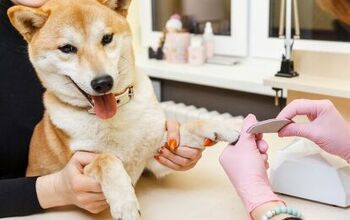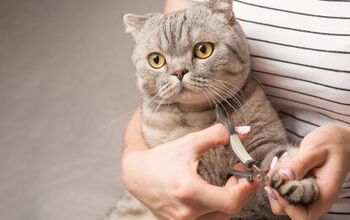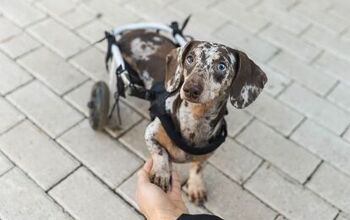How Do I Train My Dog to Wear a Muzzle?

Introducing a new tool to your dog can feel like uncharted territory. While some dogs will readily accept whatever is thrown their way, others will become stressed or anxious when presented with something new. Unfortunately, if you are in a position where a muzzle is necessary for the safety of your dog or others around you, forgoing a tool because your dog appears to be uninterested in it isn’t an option.
So, what do you do? How do you train your dog to wear a muzzle?
This guide will dig into the importance of conditioning when planning to muzzle your dog. This includes explaining what conditioning is, walking you through the process step-by-step, and sharing some helpful tips to set you up for success.
What is Muzzle Conditioning?
Before expecting your dog to wear their muzzle, it is recommended that you take the time to focus on muzzle training, also referred to as muzzle conditioning. This is the process of introducing the muzzle alongside positive rewards.
If each time your dog sees or interacts with the muzzle, they get “good things,” it will create a positive association. Over time, they will not only tolerate the muzzle but happily accept it. Why? They recognize that wearing their muzzle means they will receive good things like verbal praise, pets, and their favorite treats.
How Long Does It Take for a Dog to Get Used to a Muzzle?
There is no one guaranteed timeline when working on muzzle conditioning. While some dogs will quickly take to the muzzle, adjusting in just a few days, others will take longer. Some factors that can impact this include your dog’s personality, trainability, previous experience (positive or negative) with a muzzle, and their trust/bond with you as the person introducing this tool to them.
It’s important to keep in mind that the time it takes does NOT mean you are doing better or failing at your training efforts.
We have three dogs, all of which have been muzzle-trained. While two of our dogs took to the muzzle relatively quickly, Lucifer’s nerves and anxiety made the process more challenging. This doesn’t mean it was impossible. With time, patience, and consistency, he is now the dog that is most comfortable in a muzzle out of the three. We just had to move at his pace.
How Do You Get a Dog Used to Wearing a Muzzle: Step-By-Step
Whether you’re muzzle training your dog as a precaution in the event of an emergency or preparing for regular muzzle use, the most important thing you can do is approach the process with patience. This is a process – one that should be led speed-wise by your dog’s comfort level. As you work through these steps, carefully examine their body language. Don’t move on from one stage to the next until you can see your dog is completely comfortable with the muzzle.
Before you get started, take a moment to consider what rewards will best motivate your dog. Do they have a favorite treat? Is your dog most excited to work for a dog-friendly human food, such as a bit of ground beef or shredded turkey? Do they love peanut butter? Knowing what motivates them will make this process easier!
Step 1: Introduce the Muzzle
You will not try to put the muzzle on your dog at this stage. Instead, sit in the middle of the living room with the muzzle on the floor in front of you. Allow your dog into the room and allow them to sniff and explore the muzzle. Each time they approach and touch the muzzle, reward them. This will lay the foundation for associating the muzzle with your chosen reward(s).
Step 2: Nose in the Basket
When you see your dog either show no interest in the muzzle, like it is just another part of your living room décor, or they are clearly associating the muzzle with treats, you can move on to this next step.
Hold your dog’s muzzle up in front of you with the opening to the basket (the place where your dog’s nose goes) facing toward them. Place or hold a high-value treat inside the basket. If your dog prefers peanut butter or something spreadable, you may be able to spread the treat inside with some muzzle styles. The goal is that your dog will receive a reward each time they stick their nose in the muzzle.
If you know you will be using the muzzle regularly, as we do with Lucifer, you may wish to choose a verbal command to go with putting their nose in the muzzle to make it easier to put on in the future. For example, when I hold out Lucifer’s muzzle and ask, “Is this yours?” he places his nose in it and waits for me to fasten the buckle.
Step 3: Buckle Up!
This can be a challenging step for some dogs. Up to this point, they have had complete control over the situation and could pull away if they became overwhelmed. Instead, you are asking them to trust you as you buckle the muzzle on, taking away their control. For this reason, you may find that this step takes longer – and that’s okay!
When your dog places their nose in the muzzle to get the treat, pull the straps together or buckle it up. Only leave this buckle fastened for a second before unbuckling it and offering praise and a reward. The goal isn’t to keep the muzzle on for an extended time. Instead, you are focusing on getting over the initial shock and concern that comes with it being buckled.
Step 4: Work Up the Time
Now, it’s the stage of the muzzle training process where you will start to lengthen how long your dog is wearing the muzzle. After buckling it, wait a few seconds before unbuckling. Ensure it is always followed with something positive, like a high-value treat and plenty of praise.
Each time your dog becomes comfortable with the status quo, increase the time a little.
Eventually, you will reach the point where your dog can wear the muzzle while going about their day. Try letting them engage in activities they may engage in while wearing the muzzle, like going outside to sniff around in your yard or drinking water (any muzzle worn for an extended time should allow your dog to drink). Keep praising and rewarding your dog each time you take off the muzzle so that they maintain that positive association.
Step 5: Introduce Distractions
Your dog is comfortable wearing their muzzle in the familiarity of the home. Now what? You introduce new settings, experiences, and distractions at this point. Try taking your dog for a car ride or a walk around the block with their muzzle on. If they are comfortable going somewhere new, consider a busier area like your local park or walking through town.
While we shouldn’t have to consider this (in an ideal world), be prepared to educate and advocate for your dog. There is still a lot of negative stigma associated with the use of a muzzle. Many people will see it and automatically assume your dog is highly aggressive.
Decide how you will respond to questions or negative comments in advance, as it can help you react confidently in that moment. If you’re the type of person who prefers to avoid confrontation, it may be easier to ignore the comments of others and simply walk away. You could make a statement, making it clear that you are a responsible dog owner by ensuring that your dog is comfortable with the tool.
If you are more open to talking to and engaging with strangers, take this opportunity to educate them about the use of muzzles, the many reasons why someone may use one, and how this is a positive move for our society. By educating others, we are making a difference and shifting the view of muzzling one person at a time!
Do Muzzles Calm Dogs Down?
For some dogs, when you put a muzzle on, you may notice that they instantly calm down. This can be for one of two reasons. First, for those that are properly conditioned, a muzzle may give your dog a feeling of safety. Why? After going through the training process, they associate it with positive things and you being there to protect them.
However, if your dog hasn’t gone through training, beware. A dog that instantly calms down the first time a muzzle is introduced is likely shutting down. This isn’t a sign of being relaxed and comfortable. Instead, they are so stressed and overwhelmed that they are shutting down as a method of coping. This is why the conditioning process is so important!
How Do You Muzzle an Uncooperative Dog?
The conditioning process is the most important thing to remember if your dog is uncooperative. If your dog resists using a muzzle, they are not making that all-too-important positive association.
This can be challenging if you are in a situation where your dog is required to wear a muzzle, such as the recent XL Bully Ban in the UK. If possible, try to avoid situations where a muzzle is necessary until you have worked through the above steps. This may mean offering mental enrichment at home for a few days instead of going out in public for physical exercise. While this isn’t ideal short-term, it is the best step you can take to set your dog up for long-term success.
When Should You Not Use a Muzzle on a Dog?
While I am a major advocate for the importance of muzzle training all dogs, even those that don’t need a muzzle for their immediate situation, there are situations where a muzzle may not be recommended. More specifically, there are situations where the use of a muzzle could cause more stress and anxiety than it’s worth.
If you have adopted a rescue dog who previously wore a muzzle in a hostile environment or without proper conditioning, they may associate it with that time in their lives. This doesn’t mean you can’t condition your dog to be comfortable with the muzzle – but it will take a lot more work if possible. You will need to be even more in tune with your dog’s body language while working through the stages, keeping in mind that they may appear “calm” as they shut down from feeling overwhelmed.
Muzzles should also not be used to stop barking. This is often a mixed message, as many muzzles are marketed specifically for that purpose. However, to stop your dog from barking, a muzzle has to be too tight to allow them to pant. This means they are unsafe to wear for longer than a short vet visit or grooming appointment. If your dog is overly vocal and you want to address it, there are many better approaches through positive reinforcement training, redirecting your dog’s focus, and offering positive outlets for any frustration they may be feeling.
Final Thoughts: Training Your Dog to Wear a Muzzle
Muzzle training carries a lot of stigma, but it can be a positive and beneficial process for your dog. Even if your dog doesn’t need a muzzle to get through their daily routine today, consider the potential use for one in the future. Even the nicest, most gentle dog may snap or bite in an emergency. In that situation, your dog is already experiencing stress and anxiety – do you want to make it worse by introducing the muzzle for the first time in the middle of all that?
The secret to success is selecting the best muzzle for your dog (which will vary from dog to dog) and working through the conditioning process. This allows your dog to adjust to the muzzle while creating a positive association. Be patient, pay attention to your dog’s body language, and be consistent. You’ve got this!
Join the PetGuide community. Get the latest pet news and product recommendations by subscribing to our newsletter here.

Britt Kascjak is a proud pet mom, sharing her heart (and her home) with her “pack” which includes her husband John, their 2 dogs – Indiana and Lucifer – and their 2 cats – Pippen and Jinx. She has been active in the animal rescue community for over 15 years, volunteering, fostering and advocating for organizations across Canada and the US. In her free time, she enjoys traveling around the country camping, hiking, and canoeing with her pets.
More by Britt
























